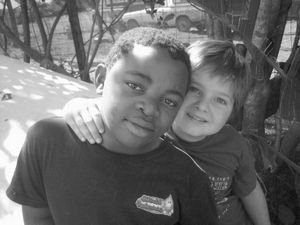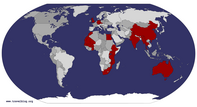Advertisement
Published: December 16th 2007

 Racial harmony
Racial harmony
The face of the new South Africa...one would hope... It is perhaps the strangest country I have ever visited. In fact, it is more like
many countries, all overlapping and sharing the same geographical space, yet interacting very little. Sometimes it feels like Australia, sometimes it feels like the US, sometimes it feels like Britain, and sometimes it feels like, well, an African country. There are plush shopping malls full of affluent white shoppers, and barred-up corner stores selling mealie maize to queues of poor Africans. There are super-smooth highways carrying along the wealthy locals in their BMWs and Mercs, and potholed country roads, where car-less locals have to trudge from home to work, and back again. There are beachside suburbs loaded up with razor-wire-surrounded McMansions, and raggedy villages of mud huts and goats. Everybody is incredibly friendly, yet everybody is paranoid about the skyrocketing crime levels. Just thinking about it now, my mind boggles at how confusing this place is.
Before I launch into this, let me explain that any use of the terms 'black', 'white', 'Asian', 'tribe' or whatever, are simply for ease of definition, and not to annoy any of you sensitive

 Washing line
Washing line
A typical rural house on the Wild Coast, South Africabastards out there.
Crossing the border from Swaziland, the first thing I saw in SA was a white immigration officer. My head has become so accustomed to black officials that I found this quite unbelievable. It took me a good few days to get used to the fact that this is a multiracial nation. And how multiracial! SA has eleven official languages, a multitude of African tribes (of which the Xhosa and Zulu are the largest), a massive Asian population, and even the whites can be split into Afrikaners and English. Every town and city here has a different racial mix, which gives it a different flavour: Durban has a large Indian contingent, and so you get a lot of curry restaurants and textile stores; while Jeffreys Bay, where I am now, has a large Afrikaner population, and so it's all biltong and braais. Sometimes you think you're in the West, especially in posh restaurants or shopping areas, and every face is white, every car is brand new. But sometimes you think you're in Africa, especially along the Wild Coast, where the Xhosa predominate, and wandering farm animals and buckets on heads seems to be the norm.
I

 Wartie and daughter
Wartie and daughter
A mother warthog with her cute little hoglet, Addo Elephant Parkwas prepared for a nation still split along the old apartheid lines, and I have had my prejudices both challenged and reinforced. I have seen black folks doing all the menial jobs, and I have seen white folks living in the street. I have seen black people driving fancy cars, and seen white guys directing traffic out of parking spaces in exchange for a few rand. I have seen gated communities of whites with not a black face in sight, and I have seen a Xhosa and white boy playing together, even conversing in the click-y Xhosa language.
But the stark reality is this: while South Africa is, for most whites, a developed, western nation, it is still a poor country. The GDP is about $6000, which is a lot by regional standards, but when you consider that most of that is in the hands of the white 13% of the country, you end up with a hell of a lot of poor black folks. Driving into the big cities here, the divide is clear - the mansions and fancy 'burbs overlooking the coast are predominantly white, and the townships - slums with erratic electricity, poor sewerage, and unemployment

 Sotho boys
Sotho boys
Three Sotho boys wrapped in their traditional blankets, Sani Pass, Lesothorates above 50%, which lie about 5-10kms out of town - are exclusively black. Political apartheid is dead. Economic apartheid is alive and kicking.
Yet South Africa is a country of outstanding beauty, and its people are more often than not friendly, helpful, and fun to meet. We began our foray into this complicated nation in Durban, and were prepared for an urban wasteland of crime, grime and curry. Instead, we ended up in a bustling, modern, and safe (well, relatively speaking) city. No, we wouldn't have ventured outside of our hostel in the red-light district after the sun went down, but during daylight hours, Durban was an exciting place to be. Free museums, a pumping beachfront esplanade (try to ignore the heavily armed cops every 50 metres keeping the peace), Asian markets, old buildings, great food (try bunny chow when you're there), and things from home I have been missing, like well-stocked supermarkets and readable newspapers; it all added up to an exhilarating experience. Keep your valuables hidden, stay locked away at night, and Durban ain't half bad.
In Durbs, we ended our love-hate affair with African buses, and hired a car for our last two weeks

 Springboks crossing
Springboks crossing
A view to the Drakensberg, with a typical South African signtogether on the continent. We began our drive with a cute little Opel Corsa (Holden Barina) that we christened Mohammed (for purely silly reasons), but Moh decided to die a premature death on the highway outside Pietermaritzburg, and after four hours of towing-related dramas, we were upgraded to a Ford Focus that we promptly named Mohammed II.
Moh II took us firstly to the spectacular Drakensberg Mountains, a range of verdant peaks and lush valleys to the north-west of Durban. We took in the amazing views, enjoyed the fresh highland air, and did a quick day trip into the mountain fastness that is the sovereign nation of Lesotho. This freakish country is entirely surrounded by South Africa, and has the highest low point of any state on earth. The bit we saw was like a cross between Swaziland and Tibet - a bunch of African shepherds, wrapped in blankets, shearing sheep,and riding horses. I even got to have a go at shearing a sheep while I was there, but after thirty seconds I had clipped off exactly no wool, and the poor Sotho guy who was losing money as I hacked at his sheep, took back over.
From

 Lesotho kid
Lesotho kid
A cheeky Sotho boy posing in my hat, LesothoLesotho and the Drakensberg, we headed into what used to be known as the Transkei, and is now called the Wild Coast. The Transkei was set apart by the apartheid regime as a 'Homeland' - an area where they could shove black Africans, and eventually leave them to stagnate socially and economically without imposing on the white population. Now it is one of the more underdeveloped regions of democratic South Africa, and the centre of the Xhosa nation. The Xhosa are one of SA's largest ethnic groups, and Nelson Mandela is perhaps the most famous Xhosa to have ever lived.
The Wild Coast is, as the name suggest,a wild stretch of coast. It is generally agreed to be the most African part of SA, and one of the few places left where traditional lifestyles are still able to be lived. The Xhosa live in round huts, farm sheep and cattle, and fish the crashing waters of the Indian Ocean coast. Back in apartheid days, the Transkei was a centre of anti-government activism, and some non-racist whites moved to the area to live a multiracial South African dream. Thus the area became something of a haven for local hippies, especially

 Sotho hut
Sotho hut
A typical dwelling in eastern Lesothothe settlement of Coffee Bay. Now, Coffee Bay is more of a spot for backpackers to come and drink beer and play drums, but it still has a unique vibe compared to the rest of the country. We spent three wonderful days there, during which I very stupidly locked the keys to Moh II in the boot of the car (requiring us to break into the car - the only time we were broken into in South Africa, and we did it), and I sang for my supper for the first time ever. We also did a fantastic walk along the coast to the 'Hole in the Wall', a diverting bit of maritime geography, along the lines of the Twelve Apostles in Australia. On the way, we were almost charged by a bull, and were asked for small change and pens by about two hundred Xhosa kids.
From Coffee Bay, we went to the seaside town of Cintsa (after getting our car window fixed in East London...). Cintsa was lovely, a bit of a scene, especially the backpackers hostel called Buccaneers, which was billed as 'South Africa's greatest hostel', but was actually a bit like a holiday camp centred

 Mandiba
Mandiba
A bronze bust of Nelson Mandela, at the Voortrekker Museum, Pietermaritzburgaround getting drunk. We enjoyed it, though, and we had our very first braai (BBQ) there, with (sorry, veggos) warthog and kudu sausages on the menu. Yummy!
Next along the coast was Jeffreys Bay, the most famous surfing settlement in the country. JB is one weird bloody place. Imagine a town on the Gold Coast. Fill it with Afrikaner folks, add a dash of edgy crime, and stick in a shop selling dried springbok meat. As I said, weird. We used it not for surfing, but as a base to visit Addo Elephant Park. This turned out to be a great lark. You can self-drive at Addo, and this adds a whole new element to the safari experience. Now, instead of your driver having to back away hurriedly when you turn the corner into a herd of buffalo, YOU have to back away hurriedly. I was the driver and safari guide, and I found us 100 elephants, a butt-load of warthogs, and plenty of mean-looking buffs. And we only got almost charged once.
So - that was our first ten days or so with Moh II. After JB, we were to move on to the wilderness-y sounding town

 Drakensberg
Drakensberg
Some of the scenery near the Sani Pass, in the Drakensberg Mountainsof Wilderness, before driving the final stretch of good South African highway to the final place on my overland trip through Africa - Cape Town, the Mother City.
Advertisement
Tot: 0.272s; Tpl: 0.013s; cc: 28; qc: 116; dbt: 0.1257s; 1; m:domysql w:travelblog (10.17.0.13); sld: 1;
; mem: 1.5mb
























Bernie
non-member comment
Come home!
OK Tom. We still have a week of school to go, and here you are swanning around South Africa. Come home, the government has changed, there's an amnesty on all your previous crimes, and all is forgiven. Great insight into the rainbow Nation. I'll be fascinated to see what you make of its future, and also its preparations for the World Cup in 2010 - do they see that as a chance to really make a splash on the world stage? Merry Christmas mate, Bernie